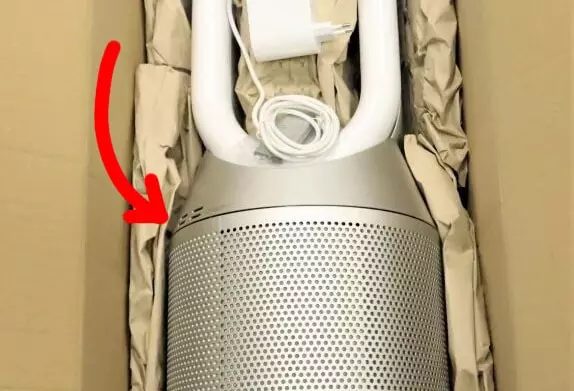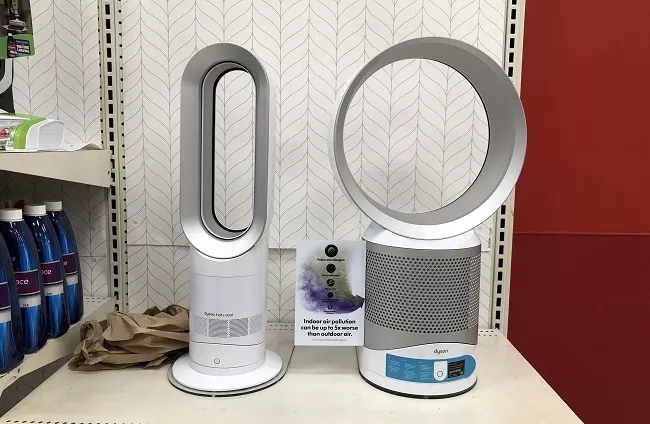It’s frustrating to find out that your Dyson fan is no longer rotating. Obviously, how would you circulate the air in your room without this feature?
Your Dyson fan may have stopped oscillating for several reasons. And usually, the issue is relatively easy to fix.
Therefore, I will share with you the most common reasons why your Dyson fan isn’t oscillating, along with troubleshooting and fixing instructions.
Quick answer: Dyson heaters usually don’t rotate if there’s still tape on your Dyson fan’s base body split section. Additionally, if the fan doesn’t fit right in its base and dust accumulates in the oscillation system (oscillation motor), the system won’t work and thus won’t oscillate.
Causes and fixes for your Dyson fan not rotating
If your Dyson fan doesn’t oscillate, you can’t circulate the airflow in your room. So, it’s essential to find out the reason and fix it.
So, I’m going to guide you through the troubleshooting process of a Dyson fan that won’t oscillate.
1. Tape on the split section
If you recently set up a new Dyson fan and couldn’t put it on oscillation, it is highly likely that you didn’t unbox it properly.
You must have skipped removing the tape around the base (which prevents your fan from oscillating).
How to check: On the bottom of your Dyson fan, you will see a split section between the base and body that is taped.
How to fix: It’s obvious! Take the tap off and let your Dyson fan oscillate.
Using the oscillation function on your Dyson fan while there is tape on the base body split section can damage the internal gear. So, make sure to remove the tap before turning it on.
 New Dyson heaters have tape on this split section
New Dyson heaters have tape on this split section
2. Fan is not assembled correctly
If your Dyson fan is not assembled correctly with its base, it will not let your fan oscillate.
Actually, the component which allows your Dyson fan to oscillate is the oscillation system (motor).
So, when you don’t assemble your Dyson fan correctly, the oscillation system also will not connect properly.
That’s why your fan will not be able to move.
How to check: Check if all parts are locked at the right point and aren’t loose. If they’re loose, then you’ve found the problem.
How to fix: Detach the fan, and try to assemble it again, but this time, make sure every part is locked at the right point.
While detaching your Dyson fan, check whether internal components are correctly connected.
3. Remote control issue
If you’re done trying both of the above fixes, and the issue still persists, I doubt that your remote control is not communicating well with your Dyson fan.
There could be an issue with your remote, or maybe you’re not pointing it rightly toward your Dyson fan.
How to check: Point your remote from the front toward the eye of your fan, and see if it works. In addition, check the batteries of your remote.
How to fix: Replace your batteries and point your remote straight toward your fan at a suitable distance.
If your issue still persists, there is a fault in the PCB of your remote. So, I’d recommend saying goodbye to your old remote and getting a new one.
4. Faulty oscillation motor
The oscillation motor is the main thing responsible for rotating your Dyson fan.
So, if there is a fault in the oscillation motor of a Dyson fan, it is likely that the fan will fail to oscillate.
How to check: If there is an issue with the oscillation motor of your Dyson fan, you’ll hear an unusual noise from the motor or no noise at all.
How to fix: You can get your oscillation motor repaired if there is minor damage. But I’d recommend replacing the motor, as there is a high chance that your oscillation system may not work to its fullest after several repairs. While connecting a new oscillation motor, make sure to check the connections carefully.
6. Dust blocking the rotor
Dust particles are the worst enemies of any electrical device, as they jeopardize the performance of electrical components.
The same is the case with a Dyson fan. Dust particles can potentially cause a Dyson fan to stop oscillating if they accumulate in the oscillation motor.
How to check: If you haven’t cleaned your Dyson heater in months, you don’t need to check it (It’s undoubtedly a reason). However, you can check if there is dust in your Dyson fan by simply detaching its body.
How to fix: Clean your Dyson fan internally and externally, and repeat the process frequently. You can clean your Dyson fan using a brush, brush with a small vacuum cleaner, or a piece of cloth. Make sure to clean your fan gently.
7. Calibration Cycle Interference
For some Dyson fan models, especially those with heating functions like the Pure Hot+Cool fans, an often-overlooked cause of oscillation issues relates to the unit’s calibration cycle.
When you activate the heating mode, these fans undergo a calibration cycle to ensure optimal performance.
During the calibration period, the oscillation function is temporarily disabled.
This is a safety and efficiency feature, not a defect. Many users, unaware of this feature, might mistakenly assume their fan is malfunctioning when it refuses to oscillate immediately after switching to the heater mode.
How to check: When you switch your Dyson fan to heating mode, allow it some time to complete its calibration cycle. The manual typically mentions this process.
How to fix: Patience is key here. Simply wait for the calibration cycle to finish. Once it’s done, the oscillation function should resume working as normal. If you’re using the remote control or app and the oscillation doesn’t engage, wait until the calibration is complete before trying again.
Understanding your Dyson fan’s unique features, like this calibration cycle, can save you from unnecessary worries and troubleshooting. Always refer to your model’s manual for specific operational characteristics.
A convenient workaround is to start the oscillating in cool mode, then simply hit the heat button. The fan will then automatically start oscillating again following the calibration.
What to do if your Dyson fan is still not oscillating?
If, after trying everything that I mentioned in this article, you still couldn’t get your Dyson fan to oscillate, then it’s time to replace your old Dyson fan.
If it’s new, you can contact Dyson support (they would help you), but if it’s old, broken, or gone through several repairs, it’s time to get a new fan.
I recommend getting a new fan. The Dyson Pure Cool Link TP02 (click to see it on amazon) is a good choice . It’s my favorite because of its price, quality, reliability, and amazing features (purifier, Wifi enabled, and auto mode).
Also, you can sell your broken Dyson fan online to get some money (some people buy broken electronics to repair and flip them).
How to control and adjust the oscillation of my Dyson fan?
To control and adjust the oscillation of your Dyson fan, follow these steps:
- Find the oscillation control button on the base or remote control (if your Dyson fan has a remote control).
- Press the oscillation button to turn the oscillation on or off.
- Not all Dyson fans have an oscillation adjustment feature. If your fan has this feature, you can adjust the oscillation angle by using the left and right arrow buttons on the remote control.
Some Dyson fans have built-in timers that allow you to set the oscillation to turn off after a specific time. You can set this using the timer control button.
